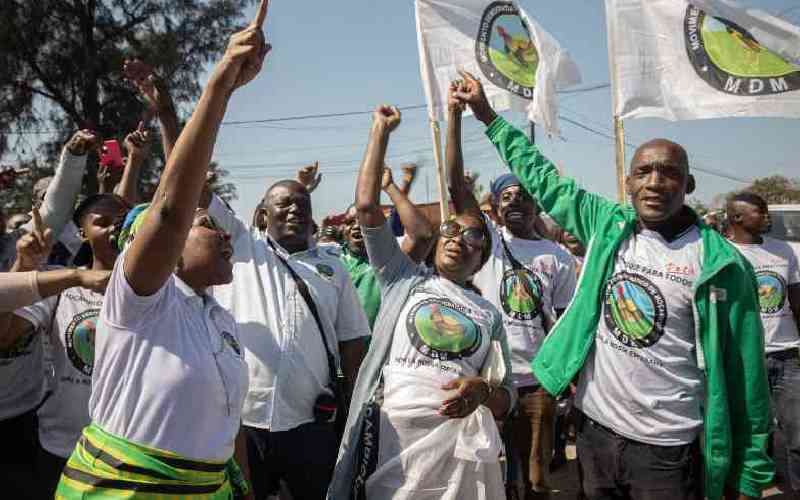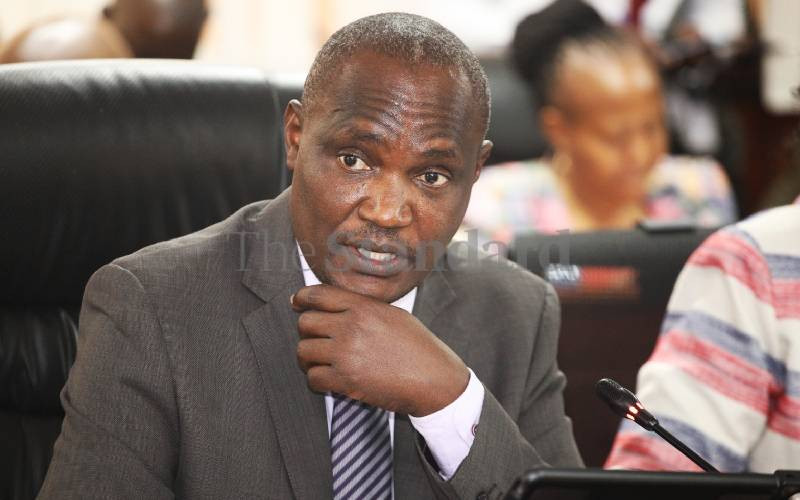
As the only child of the late Michael Kirugumi Wanjuki, 67-year-old Ndung’u Kirugumi is desperate to clear his late father’s name and the image that hangs over it as ‘The Last Hangman of Kamiti’.
Displaying a mix of puzzlement and the remnants of anger, Mr Ndung’u cuts a forlorn figure; one of a loving son discontented with the way his father was depicted by the media.
“The media reports that swirled around every now and then portraying my father as an executioner were untrue. In fact, it was the media that started calling him ‘The Last Hangman of Kamiti’,” he says.
Ndung’u says his father was a mere prison warder, not a hangman as Kenyans were made to believe.
According to him, the actual hangman was a white man who used to come from either South Africa or Northern Rhodesia (Zimbabwe). He was usually summoned one day before the D-day for condemned inmates.
His identity was known by a select few. Even senior prison officers at Kamiti Maximum Prison back then did not who he was.
Hidden identity
“Immediately the executioner arrived, the sirens at Kamiti would be turned on and he would be let through the gates without being subjected to a security search. Everyone at the prison, even the warders, was required to turn their backs when he was passing by so his identity could remain concealed. The siren was a general notification to heed this directive,” he says.
“Not even my father knew who he was, even after working at the prison for almost 50 years,” he adds.
After passing through the gates, the executioner would drive straight to the specific room where the executions were carried out. He had to arrive a day earlier for a thorough inspection of the gallows, which consisted of a noose, the frame with its crosspiece, the trapdoor and finally, a black hood that the condemned prisoner had to wear over his head.
The inspection was a necessary precaution. Why? Simply because of the weight of the death row inmate - a matter some might find inconsequential but one that was of paramount importance.
The time between the first hearing of a particular case and the sentencing could be years. Not factored in was the amount of time the condemned prisoners were allowed to exhaust all manner of appeals before throwing in the towel and resigning themselves to their fate.
Checking weight
“During this time, most prisoners would gain weight; only a few shed some kilos. This meant that the original weight recorded when one was first jailed became insignificant. So the executioner had to check if the trapdoor and the noose could support the weight of the inmate to be hanged lest the former gave in and the latter broke when the trapdoor was released,” explains Ndung’u.
Stay informed. Subscribe to our newsletter
The father of three and a resident of Kahiga-ini village, nestled on the slopes of the Aberdare Ranges in Tetu constituency, attributes his knowledge of the inner workings of the correctional facility to his brief sojourn there.
“I lived with my father in the prison’s servants’ quarters.”
Not one to follow in his father’s footsteps, Ndung’u went to school and qualified as a technician. After getting a job, he moved to Nairobi, leaving his father behind.
If his father was not the executioner, what purpose did he serve at the prison for the time he worked there?
Ndung’u narrates that Mr Kirugumi was born into a family of three children in Ihururu village, Nyeri County, in 1924. When he was five, he dropped out of Standard Two and was sent by his parents, who were tea farmers, to live with family friends in Samburu.
In keeping with tradition, he left Samburu aged 24 to undergo circumcision. He arrived in Nyeri a changed man, with only a modicum of knowledge of his native language, Gikuyu.
Afterwards, he went to Endarasha, in Kieni town, where he was hired as a farmhand.
In 1957, Kirugumi and other youths were talked into becoming warders at the Mau Mau rehabilitation camps in Nyeri by the area chief.
Subsequently in 1960, he was absorbed into the Prisons Department and posted to King’ong’o Prison as a warder.
He worked at King’ong’o for four years before he was transferred to Kamiti Maximum Prison, where he was assigned guard duties in the section that housed death row inmates. It was while he was here that he presided over an unknown number of executions.
“If there was an execution that was going to be carried out, the prison officials placed six warders on duty on that particular night. The warders’ duty was to ensure that everything was in order before the hanging,” says Ndung’u.
“One of their assignments was to escort the condemned inmate to the gallows. That duty fell mostly on my father; he was only an escort and nothing more.”
Ndung’u divulges that the last people the inmate to be hanged laid eyes on were a priest and his father. The priest prayed for the inmate, who would then be locked up in a cell all alone for around 24 hours before his final journey.
When the time was nigh, the inmate’s hands would be tied tightly behind his back. A hood would also be placed over his head. Kirugumi would then escort him to the gallows.
“My father told me that as he escorted the condemned inmates to the gallows, they would start crying. Others begged for mercy and forgiveness. But there was nothing he could do to help them since he was following orders,” Ndung’u says.
Once the door to the gallows slammed shut, it was the last Kirugumi saw of any of the inmates.
“The rest was done by the faceless executioner, again in the presence of a select few. He was responsible for leading the inmate towards the trapdoor, placing the noose around the neck and pulling the lever that would send the trapdoor flying open. Once death was confirmed, he would also lower the lifeless body from the deadly contraption.”
The executioner would then leave the rest – collection and interring of the corpse in the prison’s mass grave – to the prison authorities.
At Kamiti Maximum Prison, an officer who requested anonymity said there was a special wing where the condemned would be isolated. They were also treated differently.
“There was a special wing dealing with condemned prisoners and their diet was better,” he said, adding that the warders on duty in the wing for condemned inmates were very punctual and reserved - remaining at their posts without interacting with colleagues.
“They kept time and you could hardly find them walking around,” he said.
According to Ndung’u, the Government of Kenya has never advertised for the position of hangman at any of the maximum security facilities in the country.
“My family and I have always been angry. The assumption that my father was on the Government payroll as a hangman causes us distress. Is there anywhere in the Prisons Act indicating that someone is employed as a hangman? Of course not!” Ndung’u barks in indignation.
News station
In a 2009 interview with a local news station, Kirugumi (who was then a widower, his wife Jerioth Wangui having died in 1994) was quoted as saying: “You have to think about the ones who lost their family members (through the prisoners’ crimes). The ones who committed the crimes should be killed.”
Wearing a grey Stetson hat, brown trench coat, black trousers and shoes made from tyres (akala), the then 86-year-old retired warder gave a candid interview on a local TV station, admitting to playing a huge part in the execution of death row inmates.
Dark-skinned and sporting a rugged grey stubble, deep frown lines and black eyes, Kirugumi’s upright gait made a mockery of the walking stick he clutched firmly in his right hand. Clearly stout in both spirit and nature, he was also of the school of thought that people should be proud of their jobs.
“Work is work and if you are told to do it, you have to do it,” he said during the interview.
In his late father’s defence, Ndung’u says the media took advantage of an ailing old man.
“The media took advantage of this obvious weakness and asked him questions they wanted answered in a specific way,” says a clearly agitated Ndung’u.
“I tried to intervene during the interview but my father waved me away. Due to the respect I had for him, I kept my distance,” he adds.
In Kenya, the death penalty is the highest form of capital punishment. The last case of death by hanging in the country was reported in 1987, involving Hezekiah Ochuka and Pancras Okumu, two Kenya Air Force personnel who were found guilty of treason after plotting the failed August 1982 coup.
The executions were carried out 14 years after Kirugumi’s retirement.
“The media reported that he (Kirugumi) hanged the two. How could he when he had already retired?” asks Ndung’u.
Kirugumi also never had any nightmares about the inmates he allegedly executed as reported by the press.
 The Standard Group Plc is a
multi-media organization with investments in media platforms spanning newspaper
print operations, television, radio broadcasting, digital and online services. The
Standard Group is recognized as a leading multi-media house in Kenya with a key
influence in matters of national and international interest.
The Standard Group Plc is a
multi-media organization with investments in media platforms spanning newspaper
print operations, television, radio broadcasting, digital and online services. The
Standard Group is recognized as a leading multi-media house in Kenya with a key
influence in matters of national and international interest.
 The Standard Group Plc is a
multi-media organization with investments in media platforms spanning newspaper
print operations, television, radio broadcasting, digital and online services. The
Standard Group is recognized as a leading multi-media house in Kenya with a key
influence in matters of national and international interest.
The Standard Group Plc is a
multi-media organization with investments in media platforms spanning newspaper
print operations, television, radio broadcasting, digital and online services. The
Standard Group is recognized as a leading multi-media house in Kenya with a key
influence in matters of national and international interest.









